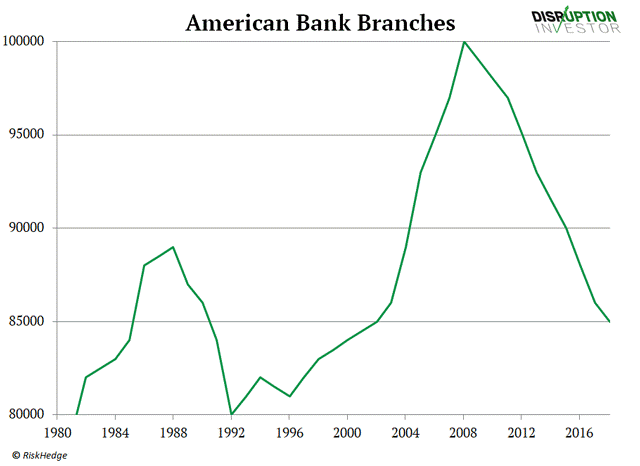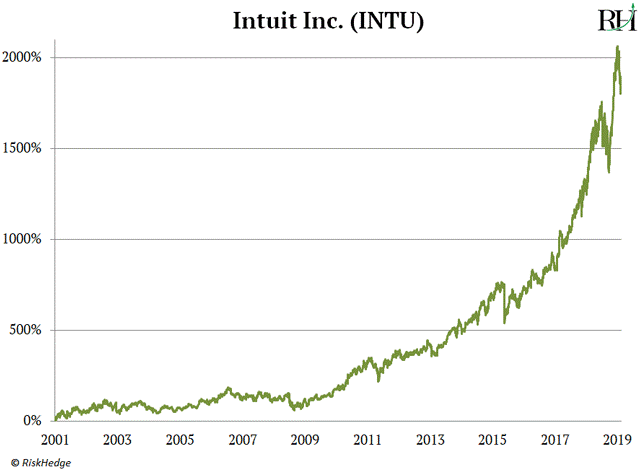Banks have grown very, very rich in the last 30 years—thanks to their privileged monopoly position.
Q1 hedge fund letters, conference, scoops etc
JPMorgan Chase (JPM), America’s largest bank, has grown profits by 2,000%+ in the last 30 years.
Bank of America (BAC), the second-largest American bank, has seen its profits surge 4,700%.
JP Morgan Chase and Bank of America are the 10th– and 13th-biggest public companies not just in the US, but on earth.
And as we all know, bankers enjoy some of the biggest salaries around. In 2017, the top five US bank CEOs earned a combined $100 million.
But quietly, banks’ grip on money is slipping away…
Bank Branches Are Closing by the Day
Did you know that since 2008, 15,000 bank branches have shut their doors?
By now most Americans know how Amazon (AMZN) has changed shopping forever.
They sell stuff online for cheap. This shut down whole shopping malls and put big stores like Toys ”R” Us, Radio Shack, and The Bon-Ton out of business.
But what many investors don’t know is a similar revolution is happening in banking. Disruptive companies like Amazon are starting to steal banks’ business.
In many ways, banking is following the same script as retail—only 10 years later.
Foot traffic in branches has fallen close to 50% in the past decade. It’s expected to fall another third in the next five years, according to financial research firm CACI.
Banks’ Physical Presence Used to Be a Great Asset
It was how they attracted new customers.
Remember when you used to get a free toaster for opening a savings account? Once folks walked in the door, banks could “upsell” expensive banking services.
These days, maintaining marble floors and fancy lobbies is mostly just a waste of money.
Sure, high-net-worth individuals may still care about these things. But most Americans just want a fast and convenient way to manage their money.
According to a 2014 Wall Street Journal study, it costs a bank roughly $4 every time you make a transaction in one of its branches.
But the average online transaction costs the bank just 17 cents!
In other words, costs drop 95% when you bank on the internet.
The average bank branch in the US costs roughly $2–4 million to set up. It costs another $200,000–400,000/year to operate, according to Mercator Advisory Group.
US bank Wells Fargo (WFC) operates roughly 8,000 branches in America. It costs between $1.6–3.2 billion/year to keep them up and running!
Non-Banking Competitors Join the Race
Just like Amazon disrupted tired old retailers, hungry competitors are picking off businesses that banks used to dominate.
Take money lending for example—a business banks had owned for centuries.
Last year, more than half of all mortgages were issued by “non-bank” lenders. That’s up from just 9% in 2009.
In fact, six of the top 10 mortgage lenders in the US today are non-banks.
Quicken Loans is both America’s largest mortgage lender and the fastest-growing firm in the industry.
Quicken does not operate branches. Instead, it evaluates borrowers using online applications. And it connects with its customers online and by phone.
Quicken is owned by Intuit (INTU)—a powerhouse “autopilot stock” I’ve liked for a long time. Its stock chart is a thing of beauty:
The “Wealth Management” Business Is Slipping Away from Big Banks
Swiss bank UBS (UBS) and Wall Street’s Morgan Stanley (MS) are the two largest wealth managers in the world.
They both get roughly half their revenue from managing clients’ money. But online “robo-advisors” are invading this lucrative business.
Robo-advisors are online platforms that give you automated, computer-driven financial planning services. They’re far cheaper than getting financial advice from a bank.
A robo-advisor might charge 0.25%–0.5% of your assets annually. Wealth manager fees typically start at 1–1.5% of your assets and can go as high as 3%.
Vanguard set up its robo-advisor service in 2018. US investors have already entrusted it with $130 billion. And it’s growing by 10–15% per year.
Vanguard operates completely online. It avoids all the costs and hassle of running physical branches. This allows it to offer the same services as a bank, but for far cheaper.
$1.1 Trillion Is Up for Grabs
The five largest publicly traded US banks are worth $1.1 trillion in market capitalization.
Disruption in banking is still in the early innings. The average guy has no clue this is happening. That’ll change as big-name banks that can’t adapt start to die off.
And keep in mind, the $1.1 trillion in wealth won’t vanish. Instead, it will change hands. Hundreds of billions will be up for grabs as disruptor stocks shake up banking, just like they did to shopping.
Now you may ask, “Where should I invest, Stephen?”
For now, stay away from bank stocks. Fintech disruptors like Quicken Loans are going to continue eating their lunch.
As I mentioned, the banking revolution is still early in the process, but investment opportunities are starting to show up.
Take a look at Global X FinTech ETF (FINX). It’s one of my favorite fintech ETFs holding most of the companies that are successfully tapping into this lucrative banking process.
This is a huge money-making trend I’ll be covering for a long, long time. Stay tuned!
Article by Stephen McBride


